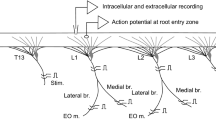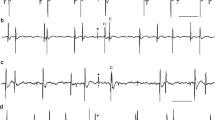Summary
In decerebrate cats some relations between synaptically firing α-motoneurones and the discharges of Renshaw cells have been investigated
1. Monosynaptic reflexes evoked by single shocks to ipsilateral low threshold muscle afferent fibres are followed by repetitive discharges of Renshaw cells. The central latency between the onset of the monosynaptic reflex and the first spike of the interneuron is usually not greater than 1 msec. 2. The number of repetitive discharges of a Renshaw cell following the monosynaptic reflex is reduced by dihydro-β-erythroidine. 3. Within limits the number of repetitive discharges of a Renshaw cell increases with the amplitude of the monosynaptic reflex. 4. Occasionally the response of a Renshaw cell seems to be unrelated to the monosynaptic discharge of motoneurones. Orthodromic stimulation of heteronymous synergistic muscle nerves then reveals that polysynaptically excited motoneurones are responsible for the firing of the Renshaw cell. 5. Renshaw cells are easily excited even by single motoneurones entering the discharge zone asynchronously. Under these circumstances the Renshaw cell changes its rate and pattern of firing from an initial high frequency burst to a more tonic rhythm. 6. We conclude that the discharge of motoneurones is the main spring for the firing of Renshaw cells following orthdromic stimulation of ipsilateral muscle afferents.
Zusammenfassung
An dezerebrierten Katzen wurden einige Beziehungen zwischen synaptisch entladenden α-Motoneuronen und den Entladungen der Renshaw-Zellen untersucht:
1. Monosynaptische Reflexe, ausgelöst durch Einzelreizungen, ipsilateraler niedrigschwelliger Muskelafferenzen, ziehen repetitive Entladungen der Renshaw-Zellen nach sich. Die zentrale Latenz zwischen dem Beginn des monosynaptischen Reflexes und dem ersten Aktionspotential des Interneurons ist gewöhnlich nicht größer als 1 msec. 2. Die Anzahl der Repetitionen einer Renshaw-Zelle, die einem monosynaptischen Reflex folgen, wird durch Dihydro-β-erythroidin reduziert. 3. Die repetitiven Entladungen einer Renshaw-Zelle nehmen in Grenzen mit der Amplitude eines monosynaptischen Reflexes zu. 4. Gelegentlich scheint die Antwort einer Renshaw-Zelle mit der monosynaptischen Entladung der Motoneurone nicht in Beziehung zu stehen. Hier deckt die orthodrome Reizung heteronymsynergistischer Muskelnerven auf, daß polysynaptisch erregte Motoneurone für die Entladungen der Renshaw-Zelle verantwortlich sind. 5. Renshaw-Zellen werden mit Leichtigkeit bereits durch einzelne, asynchron in die Entladungszone eintretende Motoneurone erregt. Hierbei gehen Frequenz und Entladungsmuster einer Renshaw-Zelle von einem initialen, sehr frequenten Entladungsausbruch in einen eher tonischen Rhythmus über. Wir sind zu dem Schluß gekommen, daß bei orthodromer Reizung ipsilateraler Muskelafferenzen die Entladung der Motoneurone die Haupttriebfeder für die Entladungen der Renshaw-Zellen ist.
Similar content being viewed by others
Literatur
Curtis, D. R., Eccles, J. C., Eccles, R. M.: Pharmacological studies on spinal reflexes. J. Physiol. (Lond.)136, 420–434 (1957).
—, Eccles, R. M.: The effect of diffusional barriers upon the pharmacology of cells within the central nervous system. J. Physiol. (Lond.)141, 446–463 (1958).
—, Phillis, J. W., Watkins, J. C.: Cholinergic and non-cholinergic transmission in the mammalian spinal cord. J. Physiol. (Lond.)158, 296–323 (1961).
—, Rvall, R. W.: The synaptic excitation of renshaw cells. Exp. Brain Res.2, 81–96 (1966).
Decandia, M., Provini, L.: Motoneurone excitability during repetitive stimulation of group I afferent fibres. Experientia (Basel)22 187–188 (1966).
——, Taborikova, H.: Mechanisms of the reflex discharge depression in the spinal motoneurone during repetitive orthodromic stimulation. Brain Res.4, 284–291 (1967a).
———: Presynaptic inhibition of the monosynaptic reflex following the stimulation of nerves to extensor muscle of the ankle. Exp. Brain Res.4, 34–42 (1967b).
Eccles, J. C., Eccles, R. M., Fatt, P.:Pharmacological investigations on a central synapse operated by acetylcholine. J. Physiol. (Lond.)131, 154–169 (1956).
——, Iggo, A., Lundberg, A.: Electrophysiological investigations on renshaw cells. J. Physiol. (Lond.)159, 461–478 (1961).
—, Fatt, P., Koketsu, K.: Cholinergic and inhibitory synapses in a pathway from motor-axon collaterals to motoneurones. J. Physiol. (Lond.)126, 524–562 (1954).
Frank, K., Fuortes, M. G. F.: Unitary activity of spinal interneurones of cats. J. Physiol. (Lond.)131, 424–435 (1956).
Haase, J.: Die Transformation des Entladungsmusters der Renshaw-Zellen bei tetanischer antidromer Reizung. Pflügers Arch. ges. Physiol.276, 471–480 (1963).
— Kuckuck, L., Noth, J.: Disinhibition der Extensor-Motoneurone nach intercolliculärer Dezerebrierung. Pflügers Arch.311, 148–158 (1969).
—, Van der Meulen, J. P.: The effects of supraspinal stimulation on Renshaw cells belonging to extensor motoneurones. J. Neurophysiol.24, 510–520 (1961).
Haase, J., Vogel, B.: Direkte und indirekte Wirkungen supraspinaler Reizungen auf Renshaw-Zellen. Pflügers Arch. (in press) (1971).
Jefferson, A. A., Schlapp, W.: Some effects of repetitive stimulation of afferents on reflex conduction. In: The Spinal Cord, Ciba Found. Symp., pp. 99–119. Ed. by G. E. W. Wolstenholme. London: Churchill 1953.
Lloyd, D. P. C.: Post-tetanic potentiation of response in monosynaptic reflex pathway of the spinal cord. J. gen. Physiol.33, 147–170 (1949).
—: Monosynaptic reflex response of individual motoneurones as a function of frequency. J. gen Physiol.40, 435–450 (1957).
Longo, V. G., Martin, W. R., Unna, K. R.: A pharmacological study on the renshaw cell. J. Pharmacol. exp. Ther.129, 61–68 (1960).
Naka, K. I.: Electrophysiology of the fetal cord. II. Interaction among peripheral inputs and recurrent inhibition. J. gen. Physiol.47, 1023–1038 (1964).
Renshaw, B.: Activity in the simplest spinal reflex pathways. J. Neurophysiol.3, 373–387 (1940).
—: Central effects of centripetal impulses in axons of spinal ventral roots. J. Neurophysiol.9, 191–204 (1946).
Wilson, V. J.: Regulation and function of renshaw cell discharge. In: Muscular afferents and motor control. Nobel Symposium I, pp. 317–329. Ed. R. Granit. Stockholm: Almqvist u. Wiksell 1966.
— Talbot, W. H., Kato, M.: Inhibitory convergence upon renshaw cells. J. Neurophysiol.27, 1063–1079 (1964).
Author information
Authors and Affiliations
Additional information
Diese Arbeit ist teilweise durch die Deutsche Forschungsgemeinschaft im Rahmen des Sonderforschungsbereiches 33 “Nervensystem und biologische Information” (Göttingen) gefördert worden.
Rights and permissions
About this article
Cite this article
Haase, J., Vogel, B. Die Erregung der Renshaw-Zellen durch reflektorische Entladungen der α-Motoneurone. Pflugers Arch. 325, 14–27 (1971). https://doi.org/10.1007/BF00587488
Received:
Issue Date:
DOI: https://doi.org/10.1007/BF00587488




